We hope you enjoyed meeting Yanjun, the first-place winner for ages 11-14 of our 2023 Science Without Borders® Challenge. It is my pleasure to now introduce you to the first-place winner in our 15-19 year-old age group, Boram Shim.
I had the pleasure of meeting Boram and her after-school art teacher, Mr. Bonjeong Koo, who instructs at the Bon Art Academy. I also briefly met with Boram’s mother, Dr. Soyoung Jung, who will be discussed further in my interview with Boram.
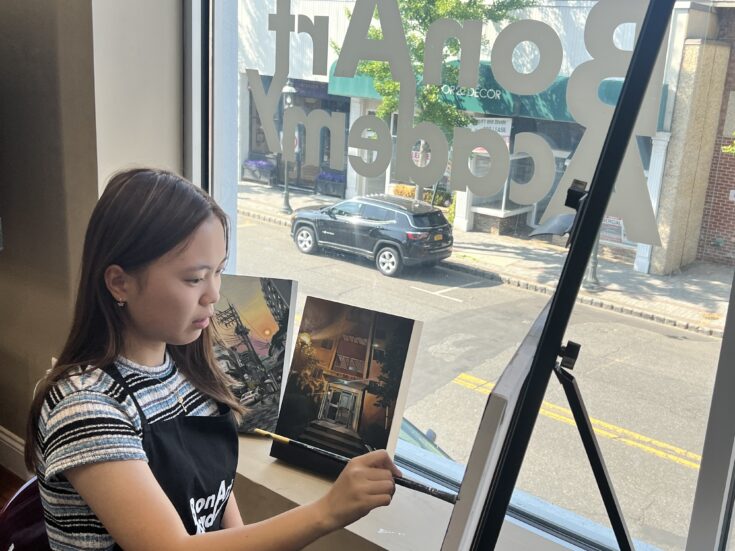
Boram attends Northern Valley Regional High School at Old Tappan in New Jersey. She just completed her sophomore year and has attended Bon Art Academy after school for the past two years.
My Zoom call with Boram may be the most memorable reaction to winning I have ever encountered. She was elated, astonished, and humbled to be named the winner of our international art contest. Mr. Bonjeong Koo, equally delighted, radiated pride as he wholeheartedly supported Boram throughout the entire conversation.
Despite Boram’s disbelief at her success, we had an incredible interview discussing her artistic inspiration, the lessons she learned by participating in our art contest, and the crucial messages she hopes people will learn about endangered marine species. Our conversation has been lightly edited for length and clarity.
AN INTERVIEW WITH BORAM SHIM
Q: Why are you excited to win this art contest?
A: Winning this contest is a huge deal for me because it is my first-ever win in an international competition. Before this, my art mainly revolved around drawing people, buildings, and objects, so tackling animals and environments was totally new to me. It was definitely a challenge, but now that I’ve won, it’s given me the confidence to keep exploring this theme and even branch out into other subjects.
Q: What inspired you to create your art piece?
A: My art piece features numerous endangered animals that have inhabited various time periods and environments. The inspiration behind this creation stems from my mother, a veterinarian. Since I was a kid, my mother would take me to the local aquarium every month to observe marine life. During these visits, she would inform me about the imminent threat of extinction and habitat loss faced by many of these creatures, making the aquarium their only refuge. Witnessing the plight of endangered marine animals left a profound impact on me. Additionally, my visits to her animal hospital provided me with valuable insights into how to interact with these magnificent creatures. These cherished memories with my mother propelled me to focus on realistically depicting the suffering of endangered animals in my artwork.
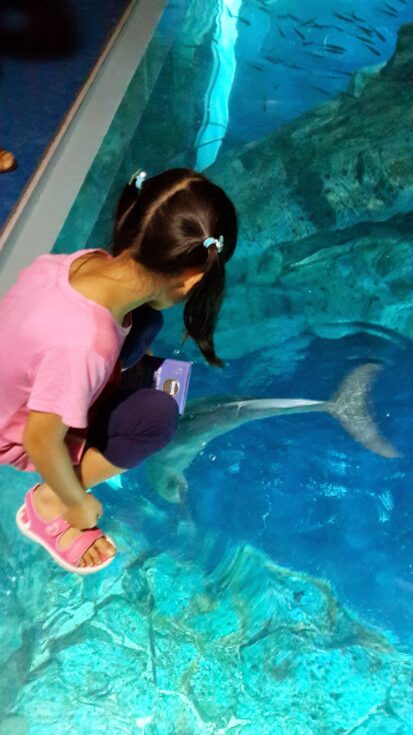
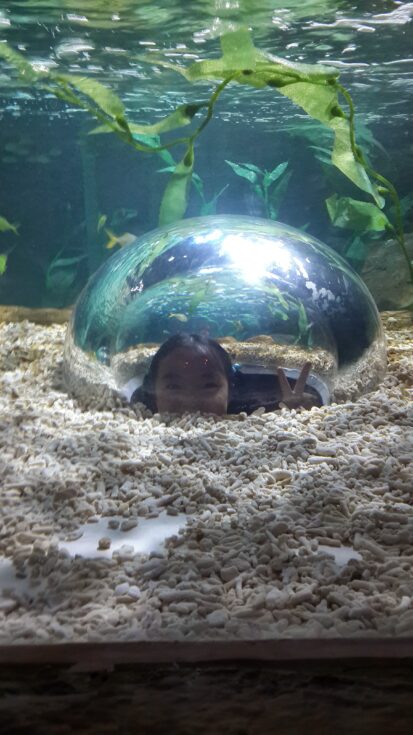
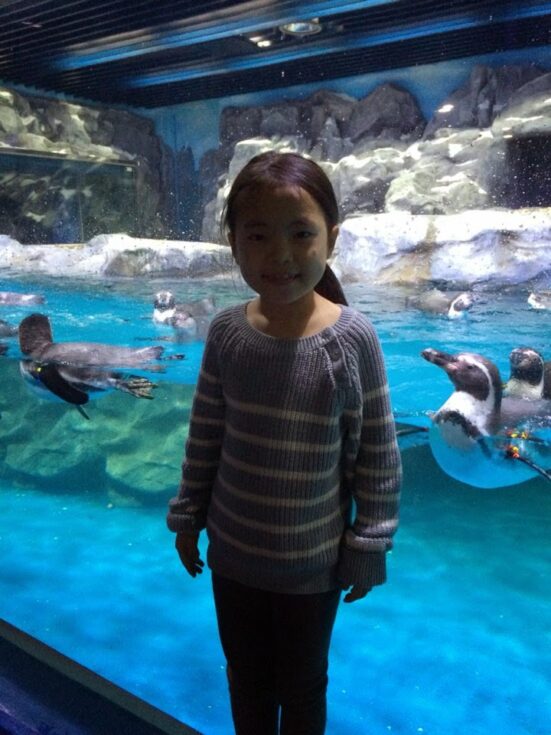
Boram’s fascination and love for marine creatures develop during memorable visits to a nearby aquarium alongside her mother.

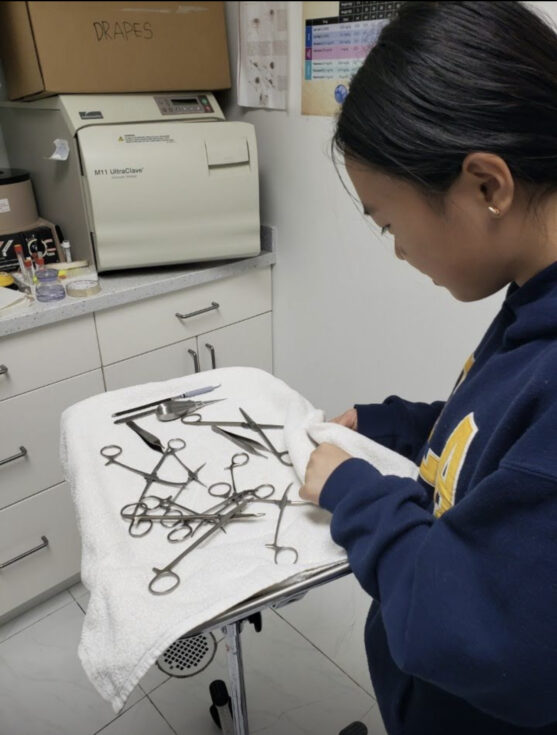
Boram visits her mother’s veterinary practice where she further interacts with animals, which has had a profound impact on her commitment to protecting animals and the environment.
Q: Why is the ocean important to you?
A: The ocean holds immense significance to me due to the potential dangers that further destruction within its realms poses to humanity. Human activities have caused a continuous decline in the essential resources provided by the ocean. As fish and other marine animals consume microplastics and inhabit polluted waters, the consequences for human health become grave when we consume them. Furthermore, the sea plants within the ocean contribute nearly 70% of the Earth’s oxygen, yet their population is steadily decreasing due to global warming. It is crucial for us to safeguard the marine ecosystem in order to protect ourselves from the repercussions that may arise.
Q: What do you want people to get out of the artwork you created?
A: Through my participation in this contest, I’ve come to realize that humans pose a greater danger than I initially anticipated. It’s crucial for people to be aware of the consequences of their actions. In my artwork, I aimed to depict the history of animal extinction, emphasizing that if we continue to harm the environment, we ourselves may face extinction, much like the mammoths, ammonites, and dinosaurs. I included several endangered species in my piece, such as the vaquita, Hawaiian monk seals, and Kemp’s Ridley sea turtle, specifically chosen due to their vulnerable status. Learning that there are only around 10 vaquitas left, and that they’re on the verge of extinction, truly devastated me. I wanted to channel this passion for their survival through my artwork.
Q: What did you learn by participating in the Science Without Borders® Challenge?
A: During my research, I discovered that numerous human activities, beyond just ocean pollution, have contributed to the endangerment and extinction of numerous animal species. For instance, I came across the distressing fact that dolphins and turtles often perish as a result of becoming entangled in gill nets. Additionally, artificial lights and chemical runoff have been identified as culprits behind significant stress, diseases, and even cancer in various animals. It’s disheartening to realize the detrimental impact our actions can have on wildlife.
Boram’s Winning Artwork
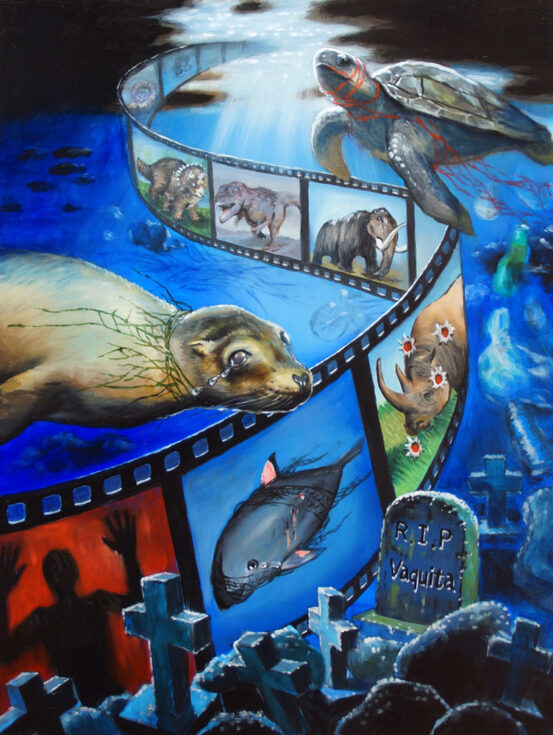
ARTIST’S STATEMENT: Humans would be the ones getting extinct at the end of the sixth extinction. I portrayed the extinct animals, an endangered dolphin, and a person lining up in a film tape as a warning that it will eventually be our turn to be extinct, like a scene in a filmstrip that would inevitably be played in chronological order. Unlike the five previous mass extinctions that occurred due to environmental pressures, “the sixth extinction” is driven by human activities like oil spills, ocean trash, and net entanglements. Vaquita is on the verge of extinction—only ten left—due to illegal fishing and entanglement in gillnets. Moreover, less than 10,000 Kemp’s Ridley Turtles are left due to pollution, overfishing, and humans’ use of artificial light. Furthermore, only 1570 Hawaiian Monk Seals are left due to net entanglements. Finally, tombstones symbolize the deaths of humans following the destruction of marine ecosystems.